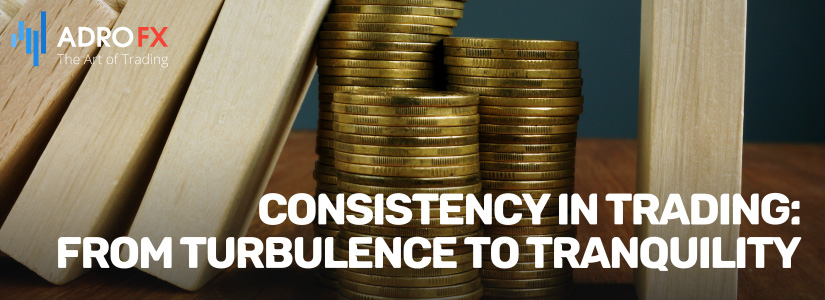Consistency in Trading: From Turbulence to Tranquility

Embarking on the journey of trading is akin to navigating the dynamic and ever-changing seas of the financial market. From extreme volatility to sustained trends, the market landscape is shaped by factors ranging from natural disasters to geopolitical events. Within this turbulence, the concept of consistency emerges as a beacon for traders seeking stability and success. In the realm of trading, consistency means the ability to navigate diverse market conditions and generate yields over the long term. Even iconic figures like Warren Buffett and Paul Tudor Jones grapple with the challenges of achieving unwavering consistency, experiencing both periods of prosperity and occasional losses. Despite these fluctuations, their enduring success attests to the reliability that consistency can bring, with Warren Buffett's compounded annual growth rate standing at an impressive 20%, surpassing the S&P 500 average of 10%.
What Does It Entail to Embody Consistency As a Trader?
The financial market is characterized by perpetual change, with fluctuations ranging from extreme volatility to sustained upward or downward trends. These changes are influenced by a myriad of factors such as natural disasters, monetary policies, variations in earnings growth, economic slowdowns, and geopolitical events, among others.
But what does "consistent" mean in the context of trading? Consistency in trading refers to the ability to generate returns across diverse market conditions over an extended period.
Even legendary figures like Warren Buffett and Paul Tudor Jones have experienced challenges in achieving consistency. They encounter phases of remarkable income potential as well as periods of losses. Nevertheless, over the long term, their overall returns tend to exhibit a certain degree of reliability. For instance, Warren Buffett has amassed billions by maintaining a compounded annual growth rate of 20%, surpassing the S&P 500 average of 10%.
Advantages of Being Consistent
There are numerous advantages to being a consistent trader or investor. Firstly, it enables the creation of a successful career by providing the ability to predict returns and losses reliably. Secondly, consistency serves as a means to master all market conditions. Lastly, being a consistent investor or trader contributes to a sense of peace of mind.
To clarify, being a consistently prosperous trader does not imply that every trade is successful. Instead, it denotes sustained financial success on a monthly or yearly basis.
How long it takes to become a consistently lucrative trader is a common question and depends on various factors. Firstly, it relies on the time spent by a new trader in their demo account, actively learning new skills. Traders dedicating more time to developing and backtesting a strategy tend to achieve lucrativness more quickly. Secondly, the trader's existing skills play a crucial role, with those proficient in areas like fundamental analysis and risk management generally achieving consistency faster.
AdroFx, with over five years of experience in the trading industry, has observed that, on average, it takes between 3 to 6 months for individuals to become successful and consistent traders.
How to Become a Consistent Trader
Learn about the market
Invest time in learning and practicing about the market. Avoid the common mistake of hastily assuming expertise after a few successful demo trades. Take the time to understand the market and practice in a demo account.
Establish a trading routine
Develop a trading routine, incorporating elements like maintaining a trading journal, analyzing premarket movers, and implementing stops for all trades. A well-structured routine significantly contributes to becoming a consistent trader.
Discipline
Emphasize discipline in your trading practices. This includes implementing SL and TP protective orders for all trades, adhering to your trading journal, trading what you know well, and positioning your trades strategically.
How to Achieve Consistent Trading Returns
Achieving consistent trading returns is the ultimate goal for traders seeking long-term success. Here are key strategies to help you on your journey:
Continuous Learning
Embrace a mindset of continuous learning about the market. Stay informed about market trends, economic indicators, and global events. Regularly update and refine your trading strategies to adapt to changing market conditions.
Risk Management
Prioritize effective risk management to protect your capital. Diversify your portfolio to spread risk and avoid overexposure to a single asset or market.
Psychological Resilience
Develop psychological resilience to navigate the emotional highs and lows of trading. Avoid impulsive decisions driven by fear or greed. Stick to your trading plan, even during challenging times, and recognize that losses are an inherent part of the trading journey.
Consistent Trading Routine
Establish a consistent trading routine that includes thorough market analysis, premarket preparation, and post-trade evaluations. Maintain a trading journal to track your decisions and outcomes, enabling continuous improvement.
Adaptability
Be adaptable in response to market changes. Markets evolve, and successful traders adjust their strategies accordingly. Stay open to new information and be willing to refine or pivot your approach when necessary.
Mentorship and Networking
Seek mentorship from experienced traders who can provide valuable insights and guidance. Engage with a community of traders to share experiences, strategies, and tips. Learning from others' successes and failures can significantly accelerate your own growth as a trader.
Utilize Technology
Leverage technology tools and platforms to enhance your trading efficiency. Stay updated on the latest trading software, analytical tools, and algorithmic trading strategies that can streamline your decision-making process.
Patience and Discipline
Cultivate patience and discipline as foundational virtues in your trading journey. Avoid the temptation to deviate from your plan based on short-term market fluctuations. Consistency often requires staying the course even when faced with momentary challenges.
By integrating these strategies into your trading approach and embracing the principles of continuous learning, discipline, and adaptability, you can increase the likelihood of achieving consistent trading returns over the long term. Remember, becoming a consistently successful trader is a journey that requires dedication, resilience, and a commitment to ongoing improvement.

Crafting the Most Consistent Trading Strategy
Developing a trading strategy that consistently delivers positive results requires a thoughtful and systematic approach. Here are key elements to consider when aiming for the most consistent trading strategy:
Clear Trading Objectives
Define clear and realistic trading objectives based on your financial goals, risk tolerance, and time horizon. Having a well-defined purpose provides a foundation for building a consistent strategy.
Technical and Fundamental Analysis
Combine both technical and fundamental analysis to gain a comprehensive understanding of market conditions. Technical analysis involves studying price charts and patterns, while fundamental analysis considers economic indicators, company financials, and global events. Integrating these approaches provides a more holistic view of decision-making.
Backtesting and Optimization
Thoroughly backtest your trading strategy using historical data to assess its performance under various market conditions. Identify strengths and weaknesses, and optimize the strategy accordingly. Regularly revisit and refine your approach based on the insights gained from backtesting.
Adaptability to Market Conditions
Design a strategy that is adaptable to different market conditions. Markets can be volatile, trending, or range-bound. A flexible strategy can capitalize on diverse scenarios, ensuring resilience in the face of changing market dynamics.
Consistent Execution
Establish disciplined execution practices. Consistency in following your strategy's rules is paramount. Avoid emotional decision-making and adhere to predetermined entry and exit points. This discipline contributes significantly to the strategy's overall reliability.
Continuous Monitoring and Adjustment
Monitor the performance of your strategy in real-time and be ready to make adjustments as needed. Markets evolve, and adjustments may be necessary to align with current conditions. Regularly review your strategy's effectiveness and adapt it to maintain consistency.
Diversification
Diversify your trading portfolio to spread risk across different assets or markets. Avoid overreliance on a single instrument, as this can expose you to undue risk. Diversification is a key element in achieving consistency over the long term.
Education and Continuous Learning
Stay informed about market trends, new technologies, and evolving trading strategies. Continuously educate yourself to remain at the forefront of market developments. A well-informed trader is better equipped to adapt and refine their strategy over time.
Evaluate and Learn from Mistakes
Embrace a mindset of learning from mistakes. When a trade does not go as planned, conduct a thorough analysis to understand what went wrong and how to improve. This iterative learning process contributes to the refinement of your strategy.
Crafting the most consistent trading strategy involves a combination of meticulous planning, disciplined execution, adaptability, and a commitment to ongoing learning. By integrating these elements, you can enhance the resilience and reliability of your trading approach over the long term.
Conclusion
In the quest for consistent trading, the advantages are manifold. It extends beyond financial gains, providing a pathway to a successful career, mastery of diverse market conditions, and a profound sense of peace of mind. The journey to becoming a consistently prosperous trader is marked by a commitment to continuous learning, disciplined execution, and adaptability to the evolving market landscape.
The path to consistency involves not just understanding the market but also seeking mentorship, establishing a structured routine, and embracing discipline. Moreover, crafting the most consistent trading strategy requires a strategic blend of clear objectives, robust risk management, and adaptability to market dynamics. By integrating these principles into your trading approach and remaining dedicated to ongoing improvement, you can chart a course toward consistent trading success over the long term.
About AdroFx
Established in 2018, AdroFx is known for its high technology and its ability to deliver high-quality brokerage services in more than 200 countries around the world. AdroFx makes every effort to keep its customers satisfied and to meet all the trading needs of any trader. With the five types of trading accounts, we have all it takes to fit any traders` needs and styles. The company provides access to 115+ trading instruments, including currencies, metals, stocks, and cryptocurrencies, which make it possible to make the most out of trading on the financial markets. Considering all the above, AdroFx is the perfect variant for anyone who doesn't settle for less than the best.











